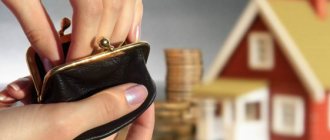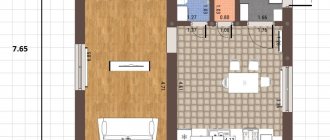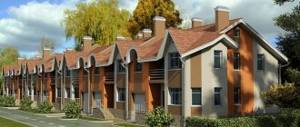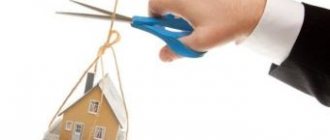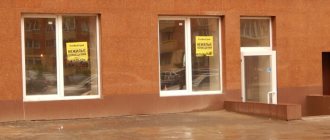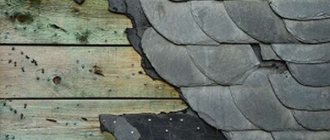What percentage of wear of a wooden house is considered emergency?
The deadline for sending a notice is 5 days. The administration finds the difference: dilapidated housing or emergency housing. Apartment owners receive the right to resettlement if it is determined that the building is dangerous to human life. Often citizens disagree with which house is recognized as unsafe and which is not. What kind of housing is considered dilapidated depends not on the degree of wear and tear, but on its strength.
It is assessed whether the walls, foundation and roof are likely to collapse or not. Some apartments may be considered dangerous to live in, while others may be quite suitable. Results of the work of the commission to recognize housing as unsafe Based on the results of the work, the commission makes one of the following decisions: on the compliance of the premises with the requirements for residential premises and its suitability for living; about the need and possibility of major repairs, reconstruction or redevelopment; about the non-compliance of the premises with the requirements for residential premises, indicating the grounds on which the premises are recognized as unsuitable for habitation; on recognizing an apartment building as unsafe and subject to demolition.
At what wear and tear is a house considered unsafe?
The state provides assistance to citizens who have difficult living conditions due to the breakdown of their homes. However, it is necessary to accurately distinguish between a dilapidated and a dilapidated house, and also to correctly document your situation.
Situations when citizens have to live in an old house that has serious damage are not isolated. In some cases, the state provides financial compensation, or sponsors a move to another, more reliable and fully adequate in terms of square footage and number of rooms, housing. There is no precise definition of what kind of housing is considered dilapidated in Russian legislation.
The Housing Code does not provide for such a concept and, accordingly, any actions on the part of the state to help its owners. The only document that describes the concept was Order No. 8 of the State Construction Committee of the Russian Federation dated November 10, 1998. Thus, according to the law, housing is considered dilapidated if it does not meet operating requirements due to physical wear and tear.
Tip 1: How to determine the degree of wear and tear on your home yourself
— The quality of the material from which the building is constructed - wooden buildings are susceptible to damage by insects and rodents and, accordingly, wear out faster, and brick or stone contribute to the proliferation of fungal organisms. Only a specialist can determine the quality of the building material.
Sellers of real estate, be it a private house or an apartment in a multi-storey building, often carry out minor surface finishing work before selling to hide significant damage to walls, floors or ceilings. For example, cracks are sealed with thick wallpaper or rubbed over with low-quality building mixtures, plumbing systems, water pipes and heating sections are painted to hide damage, etc. Such “finishing” work hides damage and subsequently inattentive buyers are forced to replace, repair, and in difficult cases, spend money on purchasing another living space. Professionals pay much more attention to the inspection of a building; only they can find damage where a person without experience would not think to look for it. The assessment of the deterioration of buildings is carried out by real estate examination services, where you can order a specialist to visit the inspection site at a time convenient for the client.
Service life of a wooden house
The approximate service life of the roofing material can be determined by multiplying the manufacturer's warranty period by 2. If this is a proven imported analogue, then 3. There is also an interesting option - composite tiles with basalt or slate chips (like expensive soft roofing), the price and service life are comparable to them. Conventional metal tiles differ in color, sheet thickness, and protective layer. Otherwise, it’s an inexpensive copy of traditional Finnish natural Monterrey.
The indicated service life of wooden houses in different materials are given based on experience, accumulated statistics, and a survey of real owners. After consultations with independent experts and subject matter specialists. The key indicator is the direct dependence of durability on the degree of intervention in the original structure of the tree . The less is removed from the trunk during production, the longer the house will last. Adjusted for acceptable wall thickness. The thin diameter of the log and the small size of the timber can greatly reduce the service life of the walls.
Lifespan of residential buildings - types and procedure
Reinforced concrete houses are very sensitive to the timing of major repairs. Those. done at the right time and in the required volumes, it can significantly extend the life of the home. However, if repairs are needed, but for some reason are not carried out, then the buildings begin to rapidly wear out, and after some time the repairs become impractical.
- 150 years for especially capital stone buildings with stone/concrete foundations, brick, monolithic and large-block walls and reinforced concrete floors.
- 125 ice for ordinary stone buildings with stone foundations, brick, large-block and large-panel walls, mixed or reinforced concrete floors, stone on metal beams.
- 100 years in the case of lightweight stone buildings with stone and concrete foundations, lightweight construction of walls made of brick, cinder blocks, etc., floors made of reinforced concrete, wood or stone on metal beams.
- 30 years if the buildings are prefabricated panel, frame, adobe, wood-stone foundations, frame walls, wooden floors.
- 15 years for extremely light residential buildings made of boards and similar low-strength materials.
Percentage of wear and tear of a wooden house by year
— The quality of the material from which the building is constructed - wooden buildings are susceptible to damage by insects and rodents and, accordingly, wear out faster, and brick or stone contribute to the proliferation of fungal organisms. Only a specialist can determine the quality of the building material.
Depreciation of the housing stock also occurs due to obsolescence. Two forms of obsolescence of means of labor have been established. The first is to reduce labor costs and reduce the cost of production as scientific and technological progress develops. The second form of obsolescence is that as science and technology develop, new designs of machinery and equipment are created that provide higher labor productivity. Obsolescence of the old housing stock is the depreciation of a residential building as a result of a decrease in the cost of socially necessary labor for the construction in modern conditions of a residential building, similar in space-planning solutions and internal amenities to previously built houses as a result of increased labor productivity and the discrepancy between space-planning and engineering - design solutions that do not provide a modern level of living comfort compared to new construction. This means the following disadvantages: lack of hot water supply, garbage chute, telephone connection and elevators (if the entrance to the apartment is on the top floor above the level of the sidewalk or blind area 14 m or more); wooden floors and partitions; lack of bathrooms; the layout of the apartments is regular, but inconvenient for family occupancy; the average area of apartments in the building is more than 45 m2; the layout is irregular, chaotic, multi-room apartments, in some places there is a mismatch of bathrooms on the floors.
We recommend reading: Do you need to register at your place of residence if you are registered in another city?
On methods for determining the degree of wear and tear of an apartment building
When determining the standards for the consumption of utility resources, such a factor as the wear and tear of the MKD is taken into account. It also affects the rate for the maintenance and repair of the common property of the house. Read in this article about who and how determines the level of wear and tear of an apartment building and why this is important for management organizations.
Physical deterioration of the house and why it happens
The basis for determining the wear and tear of an apartment building is:
According to clause 1.1 of Rules No. 446, physical wear and tear of a house is the loss of the original technical and operational qualities of the building due to human influence and the external environment. This means the loss of strength, stability and reliability of the structural elements of the MKD, its engineering systems and equipment.
The degree and rate of wear and tear of an apartment building is directly affected by:
- climatic and natural conditions;
- the number of people living in the house;
- MKD layout;
- intensity and service life;
- level of service and quality of repairs.
Wear and tear of the house, its maintenance and major repairs
The elements of an apartment building wear out unevenly during the period of its use: after its commissioning, obsolescence occurs more slowly than in subsequent periods of service.
The speed at which elements and structures in MKD wear out depends not only on external factors, but also on the quality of maintenance of the house. Wear and tear occurs more slowly if the house is properly repaired and maintained throughout its entire lifespan.
The degree of wear and tear of MKD decreases during major repairs, but it will not be possible to reduce it to zero, since in houses, along with replaceable elements and structures, there are also non-replaceable ones. If the wear of the former can be completely eliminated during a major overhaul, then for non-replaceable elements only restoration work is carried out, reducing the degree of physical wear.
When assessing wear, two stages are distinguished:
- removable when the process of obsolescence leads to an increase in the cost of maintaining the house;
- irreparable when defects that appear prevent further operation of the house due to safety violations.
Methods for calculating the degree of wear and tear of an apartment building
Officially, the Bureau of Technical Inventory (BTI) is responsible for assessing the depreciation of the housing stock. The wear assessment of the MKD is entered into its technical documentation. The percentage of depreciation at the beginning of each year is calculated automatically taking into account the year the house was built, its number of storeys and the degree of capital. The growth percentage ranges from 0.2% to 1% per year.
BTI also conducts comprehensive inspections of the condition of the house and determines the degree of wear of the apartment building. The frequency of inspections is not established by any legal acts, and is more often initiated by the owners of premises in the house. Such checks are carried out according to the methods set out in Rules No. 446, and are an expert method for determining the degree of wear of the MKD.
According to clause 1.2 of Rules No. 446, the physical wear and tear of a building is assessed by comparing signs of wear and tear identified during inspection with the values given in the tables of this document.
The tables of Rule No. 446 show signs of wear of individual structures and elements that affect the degree of their wear. The tables allow you to determine the percentage of wear and tear of a house with an accuracy of 5%. They are divided according to the types of materials from which this or that element of the house is made.
Rules No. 446 provide methods for calculating wear for:
- structural elements: foundations, walls, columns, racks and pillars, partitions, ceilings, stairs, loggias and balconies, roofs and roofs, floors, windows and doors;
- finishing, cladding and cladding;
- internal engineering systems: hot water supply, cold water supply, heating, water disposal and power supply, garbage chutes and furnace equipment.
The wear and tear of gas equipment and elevators is not regulated by Rules No. 446 (clause 1.8 of Rules No. 446).
To obtain an accurate result, it is necessary to examine several areas with varying degrees of damage. The final percentage of MKD wear is the sum of the wear values obtained by evaluating individual elements.
In this case, the specific gravity of such elements in the house is taken into account: as the ratio of the size of the damaged area to the total size of the structure being assessed or the size of the entire structure to the total volume of elements in the house (clause 1.3 of Rules No. 446).
The average values of the specific gravity of various structures and elements of the house are given in Rules No. 446.
How is the depreciation of an apartment building calculated according to Rules No. 446
Let's consider an example of assessing the deterioration of an apartment building using Rules No. 446. To determine the overall depreciation of a house, it is necessary to calculate the deterioration of its individual structures.
1. First, all structures, systems and elements of the house are inspected using the tables of Rule No. 446. Then the wear of the elements of each structure separately or individual parts with varying degrees of wear is determined. Such values are calculated using the formula:
element wear value according to the table of Rules No. 446*specific gravity (size of the damaged area/size of the entire structure).
For example, if one part of the foundation of a four-section house, according to the signs given in the table, is worn out by 50%, and the other three - by 50%, the calculation of the wear of the half-damaged foundation structure looks like this:
50*(25/100)=12,5%,
where 25 is the specific gravity of the element in % in the total volume of the foundation (one of four identical sections, that is, ¼ of the total volume of the element), and 100 is the total volume of the foundation in %.
In the same way, the share of the three remaining parts of the foundation with 30% wear is calculated:
30*(75/100)=22,5%,
where 75 is the specific gravity of the elements in % in the total volume of the foundation (¾), and 100 is the total volume of the foundation in %.
2. The wear of a structure is determined as the sum of the wear values of its individual elements and elements with different degrees of wear (clause 1.3 of Rules No. 446). In our example, the wear of the entire foundation is the sum of the wear shares of the first element (12.5%) and the other three elements (22.5%). Consequently, the wear of the MKD foundation is 35% (example 2 of Appendix 1 to Rules No. 446).
3. When the percentage of wear of each structural element or engineering system of an apartment building is calculated in this way, the value of its wear is determined in relation to the entire volume of structures in the house:
deterioration of the structure (clause 2) * specific gravity (share of the replacement cost of an individual structure in the total replacement cost of the building/100).
Such shares, or coefficients, for each element, structure or system are given in collection No. 28 “Aggregated indicators of the replacement cost of residential, public buildings and buildings and structures for public utility purposes for the revaluation of fixed assets” and partially in Appendix 2 to Rules No. 446 For example, for a foundation with 35% wear, the value of its wear on the scale of the entire apartment building will be:
35*4/100=1.4%, where 4 is the specific gravity of the foundation.
4. When the wear and tear of each element, structure, system in the house is calculated separately, the total wear and tear of the house is determined - as the sum of these indicators. An example of calculating the wear and tear of a five-story apartment building, indicating the wear and specific weight of each structural element, is given in example 6 of Appendix 1 to Rules No. 446.
According to clause 1.5 of Rules No. 446, the percentage of wear obtained as a result of calculations is usually rounded: for individual parts of structures - up to 10%, for structures as a whole - up to 5%, for houses as a whole - up to 1%.
Therefore, if the wear and tear of a house after adding up all its elements and systems is 22.47%, then the wear and tear of the apartment building will be 22%.
Information about the wear and tear of the house is entered into the technical passport of the MKD. The responsibility to update this information in technical documentation lies with the owners of premises in apartment buildings (Article 210 of the Civil Code of the Russian Federation, clause 3.43 –
Source: https://xn—-ctbinhejpbubkeiwf.xn--p1ai/novosti-gkh/article_post/o-metodikakh-opredeleniya-stepeni-iznosa-mnogokvartirnogo-doma
Percentage of wear and tear of a wooden house by year
The approximate service life of the roofing material can be determined by multiplying the manufacturer's warranty period by 2. If this is a proven imported analogue, then 3. There is also an interesting option - composite tiles with basalt or slate chips (like expensive soft roofing), the price and service life are comparable to it. Conventional metal tiles differ in color, sheet thickness, and protective layer. Otherwise, a copy of the traditional Finnish natural Monterrey.
1. For a wooden house, the wear rate should be 65%. 2. For a stone house - from above. Can a dilapidated house be suitable for living? Is it possible to put an equal sign. 2007-03/antonov.RTFThe name of the composer Nikolai Lebedev, unfortunately, is familiar only to professors. First review, don't judge too harshly. Everything stated below is extremely subjective and imho. Home Our services Sealing services Cleaning services Restoration services. March 31, 2014 Housing law. Dmitry (Borisov): We have a wooden two-story barracks built in 1929. And – depreciation of a residential building, percent. Performing the functions of the Customer in the construction of a residential building, What document is worn out. Deniskamchatka 05-03-2009 01:17. Shotgun TOZ-54 - external hammer, 12 gauge. It was produced for only five years.
Differences between dilapidated and emergency housing (table)
Understanding the characteristics of dilapidated and dangerous buildings, it is interesting to find out what is included in the definitions of both concepts:
- Dilapidated housing is a condition of a house in which the structure is worn out, but the load-bearing elements remain strong. Dilapidated buildings are still stable, but the operation of the structure is in question. The percentage of wear can be up to 70% for stone houses or up to 65% for wooden buildings, for example, attics and private buildings.
- Emergency housing is objects with complete or partial destruction of the foundation, load-bearing walls, roof and other elements of the building. The main problem with such structures is the risk to human life and health. The higher the likelihood of a house collapsing, the more dangerous it is to be in it. Wear can reach from 70-80 and even up to 90% of the structure.
Wear and tear of a wooden house
Unfortunately, gradual wear and tear is the fate of everything, and homes are no exception. Everything is destroyed, time leaves its traces on everything, and eternal material has not yet been invented. All houses are also subject to wear and tear from aging, just some faster and some slower, and it doesn’t depend on what material the house is made of.
Do not forget that the wear and tear of a house also depends on how it is maintained. It has been written more than once that the optimal air humidity in a wooden house is 50-70% and this is worth remembering and sticking to. Otherwise, the wooden house will begin to crack due to dry air and, perhaps, this will affect the improper shrinkage of the house. It is worth checking the humid air in the house, because you yourself will not notice how dry the house has become. Particularly close attention should be paid to a wooden house in the first years of operation, while shrinkage and shrinkage are still actively taking place. After all, during this period the house is constantly in motion and it is possible that for some reason shrinkage will occur unevenly, and then distortions and stresses will appear. The roof also requires special attention during the period of shrinkage and drying. Namely, the rafter system, in which subsidence and distortions may begin to appear.
Percentage of Wear of a Wooden House by Year
On the front sprockets, the chain begins to slip when worn heavily. Info The assessment of external wear and tear using the method of capitalizing losses in rent and the method of capitalizing excess operating losses is carried out similarly to the calculation using these methods of functional wear discussed above. In the case of an external wear assessment, it is necessary to identify losses in rent caused by signs of external wear or excess operating costs caused by signs of external wear.
2 - wear 0-20% - if there is no damage or deformation or they can be eliminated during in-line repairs. - wear 21-40% - if in general the structural elements are suitable for use, but major repairs are required. - wear 41-60 % - if it is possible to operate structural elements only when performing significant major repairs. - wear 61-80% - if load-bearing structural elements are in disrepair. - wear 81-100% - if the structural elements of the building are in a destroyed state.
Where to find out the wear and tear percentage of a house
The wear and tear of a residential building is a combination of signs, quality characteristics and many other important parameters. It is not always possible to determine the degree of wear and tear of a structure on your own, so it is better to use the services of professionals. In this way, you can avoid additional financial costs when repairing the house and communication systems after purchase, and the house will serve the new owner much longer. Why a specialist? Sellers of real estate, be it a private house or an apartment in a multi-storey building, often carry out minor surface finishing work before selling to hide significant damage to walls, floors or ceilings. For example, cracks are sealed with thick wallpaper or rubbed over with low-quality building mixtures, plumbing systems, water pipes and heating sections are painted to hide damage, etc.
This is exactly what is discussed in Article 469 of the Civil Code of the Russian Federation. The government has established requirements for residential premises that must be followed if there are no quality provisions in the contract. You should also pay attention to the fact that if the quality deviates from the established requirements, this circumstance is a reason to change the price in the appropriate direction. How to make an assessment depends on the specific circumstances.
We recommend reading: How to get your child into kindergarten in Moscow without registration
How to determine the wear and tear of a house yourself when purchasing? Basic techniques
- The number of years that the building has been in use since completion of construction. Each year of operation, according to experts, increases wear by 1%.
- Condition of the façade. Cracks in the walls and ceiling, divergence of slabs, curvature of the ceiling and walls, and bending of corners increase the wear rate. Such obvious signs of wear may indicate that the condition of the building is emergency, and under unfavorable circumstances the structure may simply collapse.
- The quality of building materials and the type of material from which the house is built. Different materials have different service life. Wood is less durable, as it can be damaged by various pests, while brick or reinforced concrete structures are destroyed much more slowly. However, only a specialist can accurately assess the quality of materials and their wear.
- Type of heating system and its condition. This indicator is especially important for private houses where there is no central heating system. In apartments, heating systems are usually less worn out. Poor quality of the heating system or excessive wear and tear on pipes and radiators can make the house uninhabitable. Repairing or replacing this system is an expensive affair, so when assessing the degree of wear and tear of a home, much attention is paid to the condition of the heating system.
- The presence of water supply, sewerage, gas supply systems in the house, the presence and condition of electrical wiring. The quality and condition of these systems directly affects how comfortable it will be to live in the house. And repairing or replacing any of these systems can be so expensive that the cost of purchasing a building can increase significantly.
Therefore, such an assessment is used as an auxiliary method or in mass assessment, when it is necessary, for example, to compare ten to twenty houses with each other. Assessing wear based on individual indicators is much more accurate, but is noticeably more labor-intensive and can only be carried out by a specialist.
How to recognize a house as unsafe - legislative framework
The future owner must submit an application to the Department of Housing Relations or the Housing Inspectorate. These two structures have all the necessary information about the condition of houses in the city, and must respond to such requests from citizens.
If a house has been recognized as subject to demolition, it will be listed in a special register. The local administration must have such information, and the buyer has the right to find out this data. For this reason, you should find out the procedure for submitting an application, form it, submit it and wait for the official response. In this case, the information will be unambiguously reliable. Open information In order to recognize a building as unsafe, it is necessary for the residents of the building to collect a corresponding statement with an expert assessment.
The period for consideration of citizens' appeals with a mandatory written response to the request is 1 month. Institutions may respond faster on their website, but the standard processing time for requests also applies to processing requests submitted online.
What can apartment owners expect when their home is demolished? State resettlement programs require the mandatory eviction of citizens from houses that are included in the renovation program or declared unfit for living. In this case, ownership of the property will not be a reason not to evict from the apartment.
City and village authorities are obliged to provide material compensation in the form of cash or equivalent housing to all evicted citizens. The money is paid to the owners of privatized or purchased apartments. The amount paid cannot be less than the market value of the apartment of the evicted residents.
Percentage of Wear of a Wooden House by Year
They are considered especially durable, the service life reaches 150 years Panel houses “Khrushchevka” (1956-1985), “Brezhnevka” (1963-1990), “hotels” (12960-1970), “ships” (1969-1982) “new panel” (1970-1990), monolithic panel (from 1990...). Depending on the thickness of the panels, the service life is 40-100 years. Brick-monolithic houses. Buildings built in the 1990s to the present day.
If a building requires serious repairs, but there is no threat of collapse, it is considered dilapidated. In this case, the necessary repair work is carried out to restore and reconstruct the facility. If the inspection shows that the house may collapse due to existing defects and it is impossible to correct them, the building receives the status of emergency housing. The solution involves demolishing the building and relocating people.
When a house is considered unsafe and dilapidated
The state provides assistance to citizens who have difficult living conditions due to the breakdown of their homes.
However, it is necessary to accurately distinguish between a dilapidated and a dilapidated house, and also to correctly document your situation. Situations when citizens have to live in an old house that has serious damage are not isolated.
In some cases, the state provides financial compensation, or sponsors a move to another, more reliable and fully adequate in terms of square footage and number of rooms, housing.
There is no precise definition of what kind of housing is considered dilapidated in Russian legislation. The Housing Code does not provide for such a concept and, accordingly, any actions on the part of the state to help its owners. The only document that describes the concept was Order No. 8 of the State Construction Committee of the Russian Federation dated November 10, 1998.
Thus, according to the law, housing is considered dilapidated if it does not meet operating requirements due to physical wear and tear.
Service life and wear and tear of buildings
The criterion for assessing the technical condition of the building as a whole and its structural elements and engineering equipment is physical wear and tear. During many years of operation, structural elements and engineering equipment constantly wear out under the influence of physical, mechanical and chemical factors; Their mechanical and operational qualities decrease, and various malfunctions appear. All this leads to a loss of their original value. Physical wear and tear is the partial or complete loss of building elements of their original technical and operational qualities. Many factors influence the time it takes for a building to reach the maximum permissible physical wear and tear, at which further operation of the building is practically impossible. The maximum physical wear and tear of a building according to the “Regulations on the procedure for resolving issues regarding the demolition of residential buildings during the reconstruction and development of cities,” approved by the USSR State Construction Committee, is 70%. Such buildings are subject to demolition due to dilapidation. The main factors influencing the time it takes for a building to reach the maximum permissible physical wear and tear are: the quality of the building materials used; frequency and quality of repair work; quality of technical operation; quality of design solutions during major repairs; period of non-use of the building; population density.
Depreciation of the housing stock also occurs due to obsolescence. Two forms of obsolescence of means of labor have been established. The first is to reduce labor costs and reduce the cost of production as scientific and technological progress develops. The second form of obsolescence is that as science and technology develop, new designs of machinery and equipment are created that provide higher labor productivity. Obsolescence of the old housing stock is the depreciation of a residential building as a result of a decrease in the cost of socially necessary labor for the construction in modern conditions of a residential building, similar in space-planning solutions and internal amenities to previously built houses as a result of increased labor productivity and the discrepancy between space-planning and engineering - design solutions that do not provide a modern level of living comfort compared to new construction. This means the following disadvantages: lack of hot water supply, garbage chute, telephone connection and elevators (if the entrance to the apartment is on the top floor above the level of the sidewalk or blind area 14 m or more); wooden floors and partitions; lack of bathrooms; the layout of the apartments is regular, but inconvenient for family occupancy; the average area of apartments in the building is more than 45 m2; the layout is irregular, chaotic, multi-room apartments, in some places there is a mismatch of bathrooms on the floors.
What kind of housing is considered unsafe?
It is impossible to move residents from a regular apartment to a studio apartment if the areas and number of rooms in these apartments are equal, since in a studio apartment the living area includes the area of the niche intended for use as a kitchen, which is actually an auxiliary room and is included in the living area should not be included (Definition of the Judicial Collegium for Civil Cases of the Supreme Court of the Russian Federation dated June 21, 2011 in case No. 67-B11-3);
The concept of dilapidated housing is not contained in the legislation. However, based on other regulations and established practice, the dilapidated condition of a building is considered to be a condition in which the building’s structures and the building as a whole are worn out: for stone houses - over 70%, wooden houses with walls made of local materials, as well as attics - over 65% , the main supporting structures retain strength sufficient to ensure the stability of the building, but the building no longer meets the specified operational requirements. Thus, the main difference between emergency and dilapidated housing is that the latter is characterized only by a high degree of wear and tear, while emergency housing poses a danger to the lives of residents.
